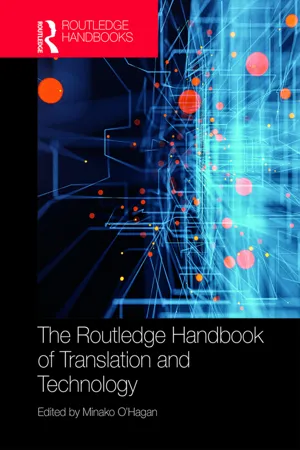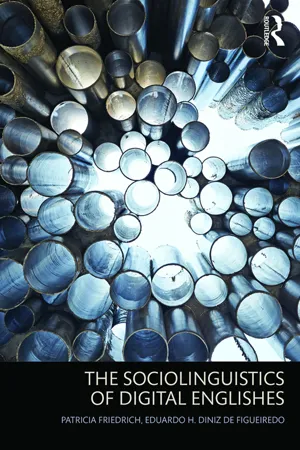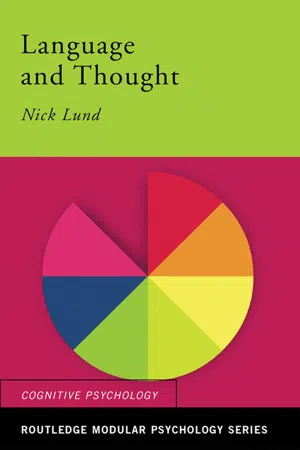Languages & Linguistics
Language and Technology
Language and technology refer to the intersection of language studies and technological advancements. This field explores how technology impacts language use, communication, and learning, as well as how language influences the development and use of technology. It encompasses areas such as natural language processing, machine translation, language learning apps, and digital communication platforms.
Written by Perlego with AI-assistance
Related key terms
Related key terms
1 of 4
Related key terms
1 of 3
6 Key excerpts on "Language and Technology"
- Minako O'Hagan(Author)
- 2019(Publication Date)
- Routledge(Publisher)
12 Technology, technical translation and localization Debbie Folaron Introduction: interconnected features of language, materiality, context and history Communication lies at the very core of human experience. Historically, human practicality, creativity, ingenuity and the impulse to interact socially have harnessed and driven the need to communicate and relay information to peers. Written communication and translation are inextricably linked to each other, contingent on pivotal and overlapping aspects worthy of acknowledgement. Both are comprised of the written word and the medium in which the written word is inscribed, hinging on important a priori knowledge: script(s) as symbolic representation of language(s); literacy; and dependence on a wide range of linguistic and cultural conventions and protocols. Both serve manifold purposes: to commit to memory; to document; to inform; to connect and communicate. Both not only ensue from a configuration of social and cultural influences, economic trends, financial factors and external stimuli; they are also intrinsically tied to the tangible, material developments of technical and technological devices and instruments over time. This shared genealogy is variegated and diverse, with artefacts encompassing ancient clay tablets to contemporary digital objects, and modalities that range from handwriting to digital 3D printing. Finally, both evolve in continuing relation to the transport and signal processing technologies that have emerged historically. Once solely dependent on human and animal mobility, the time/space ratio from production to distribution and circulation of content to be communicated has been compressed to the point that some automated processes can allow for delivery in real time. The history of human communication comprises a complex tapestry of interweaving filaments of disruption, innovation and transformation as humanity constantly adapts to changing circumstances – in multiple languages- eBook - ePub
- Patricia Friedrich, Eduardo Diniz de Figueiredo(Authors)
- 2016(Publication Date)
- Routledge(Publisher)
Introduction Language, Englishes, and technology in perspectiveThis chapter will help you understand that:- Language use is a social activity, and humans are part of networks and speech communities.
- Englishes spread through several different waves of influence, including during the industrial revolution, in the post-World War II period, and with the development of the Internet.
- Linguistic change and technological advancement have often had a close historical connection.
- The Internet caused us to fuse oral and written modes of communication and thus adopt new norms and strategies for effective interaction.
- Dialects, both in the real world and the digital world, can be construed to be as large as a nation and as small as a person.
- The English language has spread so far that it has become both many Englishes and a global language.
- New communication technologies tend to bring about fears regarding the future of language.
- Questions about standard language are better addressed if we take into consideration issues of power and attitude; Internet standards are no exception.
Language: A prequel
The details surrounding the origin of human languages are much disputed in linguistic circles. We often joke that the absence of recording devices (and apps!) makes it very hard for us to indicate with any precision the exact moment humans started to engage in oral communication. Several researchers claim humans have used language for at least many thousands of years, while others date language as existing even earlier.The human capacity to produce language depends on both brain function and, in the case of oral communication, suitability of the speech apparatus , that is, the group of organs and structures involved in speech such as the mouth, the tongue, and the larynx with its attached vocal cords. Hence, not only does the brain need to be ready for language, but also the parts of the body involved in speech have to have certain characteristics to be able to produce the complex sounds of natural languages - eBook - ePub
- Jeanette Sakel(Author)
- 2015(Publication Date)
- Routledge(Publisher)
2 What is language? IN THIS CHAPTERThis chapter discusses what makes up language, attempting a definition of the phenomenon of language. I will also discuss different ways in which communication can take place. In particular, I will look at:• Definitions of language • Spoken and written language • Sign language, including baby signing • Indigenous languages • Descriptive and prescriptive approaches to language.2.1 DEFINING LANGUAGEWhat is language? Why, that is an easy question, surely? Or is it? I reckon if we wanted to find a definition for language, we would say that language is spoken, that people use it to communicate. Yet, someone may counter, language can also be written. Furthermore, in the case of sign languages , languages can be signed. Language can also exist merely as thought, and even then used as a medium for communication, for example in thought-controlled devices for severely disabled people. In this case it is neither spoken, written, nor signed. If we wanted to define all that is language, we would have to capture these different channels of communication in our definition. We could, for example, say that language is visible, audible or perceptible in other ways.Despite the differences between the channels of language, they all transmit information and facilitate communication. Yet, the way in which meaning is transmitted is not necessarily straightforward. For example, the words or signs used to represent the thing talked about often have very little to do with that thing itself. Take, for example, the English word dog. There is no real link between this word and the animal itself. Other languages use different words to refer to the same animal, e.g. hund (Danish), koira (Finnish), perro (Spanish), achae (Mosetén). Hence, the relationship between the animal ‘dog’ and the word used for it is random, conventional and arbitrary - eBook - ePub
The Emergent Organization
Communication As Its Site and Surface
- James R. Taylor, Elizabeth J. Van Every(Authors)
- 1999(Publication Date)
- Routledge(Publisher)
Chapter 4
Language as Technology and Agent
In this chapter we explore some of the ways that language, even as it serves as the medium of communication, also independently structures the latter’s outcomes. We look at language as a technology that, as with many other technologies, is the end product of a long history of cultural development, resulting in its having its own built-in agencies, traces of yesterday’s experience and learning. It is these built-in agencies that make it capable of shaping our purposes, as we shape its. If conversation and the circumstances in which it occurs take on meaning by being mapped to text then we are here concerned with what might be called the value added of the mapping, that is how the text not only translates, but defines, reality for us and thus simultaneously enables and constrains our interaction.The chapter has two parts. In the first, we review a current theory that treats language as technology: the science of language-as-object, modern linguistics. In the second part, we consider what kind of agencies language may be incorporating and how it might thus mediate action.Some readers may find the material of this chapter difficult because it introduces figures borrowed from linguistics. For those readers we suggest they turn immediately to chapter 5 since the investigation we undertake here is not essential to understanding the ideas developed there or in later parts of the book. Our purpose in this chapter is to explore the conceptual bases of the theory of coorientation we introduced in chapter 2, and some of its implications.LANGUAGE AS TECHNOLOGY
In no other era has language attracted the intense scrutiny it has in the 20th century. It has, for example, been a prime concern of philosophy.1 - eBook - ePub
- Nick Lund(Author)
- 2014(Publication Date)
- Routledge(Publisher)
2 The relationship between language and thought DOI: 10.4324/9780203695012-2 Introduction The linguistic relativity hypothesis Thought determines language The interdependence of language and thought Summary Review exerciseIntroduction
One feature that sets human communities apart from animal communities is the use of language. Language is a vital part of every human culture and is a powerful social tool that we master at an early age. A second feature of humans is our ability to solve complex and/or abstract problems. Although some animals are capable of solving simple problems none are capable of solving the problems involved in something like space exploration or even in the designing of a psychology experiment. For centuries philosophers have questioned whether these two abilities are related and, if so, what the nature of the relationship between language and thought is. At the beginning of the last century psychologists joined this debate and it is a topic that is currently generating a lot of research.Another factor in the study of language and thought is the role of culture. When we study a language from another country we realise that it is not just the words and grammar that are different but the customs and traditions as well. Even the ideas of that culture and the way of dealing with life can be different. If people speaking different languages have different customs and ideas it raises the following question: do different languages lead to different ways of thinking?Although there is some debate about the extent of language in thinking (see, for example, Carruthers, 1996 - eBook - ePub
Brave New Digital Classroom
Technology and Foreign Language Learning, Third Edition
- Robert J. Blake, Gabriel Guillén(Authors)
- 2020(Publication Date)
- Georgetown University Press(Publisher)
Misconceptions abound concerning both technology and L2 language learning (also see Egbert, Paulus, and Nakamichi 2002; Lam 2000). In the first place, some language professionals refer to technology as if it were a single, monolithic concept. This misunderstanding might suggest that technology is either all good or all bad—that is to say, all technology is the same. Second, some teachers who are overly enthusiastic about technology tend to confuse the use of technology with some new and superior methodological approach to language teaching, although, in truth, new digital technologies only offer a new set of tools that can function in the service of a particular language curriculum. In other words, how these tools are used and to what principled ends will define the scope of a methodology, but the mere use of technology by itself will not necessarily improve the L2 curriculum. Third, all of us would like to believe (although we know better) that today’s technology is sufficient for tomorrow’s challenges. The fact that technology is constantly changing constitutes a frightening barrier for many language professionals who fear that because they cannot possibly keep pace with new advances, why even try? Finally, some in the language profession suffer from a fear that technology will replace them. Let us look more carefully at these four misconceptions about using technology in the service of the foreign language curriculum.Misunderstanding 1: Technology Is Monolithic—False
Have you noticed how people use the word the cloud in an almost mystical fashion? “Ah, the cloud . . . ,” they say, as if one word says it all. There is not one technology best suited for language study; instead, there is an array of technological tools that can be harnessed, efficiently or otherwise, to the end of learning an L2 or studying the SLA process. Moreover, these technological tools change very rapidly, going from the least to the most interactive platforms. Each tool has its own special affordance or advantage for studying an L2, as we examine in chapter 3 .Misunderstanding 2: Technology Constitutes a Methodology—False
No SLA theory has anything to say directly about language teaching; the field’s principal goals consist of studying the process of how languages are acquired, not how they are taught. Nevertheless, particular teaching methodologies (e.g., total physical response, the Natural Method, the communicative classroom, or focus on form [Fonf]
Index pages curate the most relevant extracts from our library of academic textbooks. They’ve been created using an in-house natural language model (NLM), each adding context and meaning to key research topics.
Explore more topic indexes
Explore more topic indexes
1 of 6
Explore more topic indexes
1 of 4





